How to Choose Your Kitchen Tiles & Backsplash + Tiling Trends by Tile Depot

While the bathroom might be the most used room in the house, a kitchen is easily the most hardworking room of a home. It is more prone to wear and tear because of high foot traffic with constantly having to withstand spills and cooking mess which means that your kitchen floor must be durable.
The evolution of our lifestyles also means that more homes in Auckland have an open planned kitchen which is connected to the living and dining room. The kitchen of today is easily visible from other living areas of the house which means that it must be uncluttered and aesthetically pleasing.
If you spend quite a bit of your time in the kitchen then you should choose a kitchen flooring that is comfortable to stand on. Today’s kitchens therefore wear several hats and need to be durable, strong, beautiful as well as comfortable on your feet.
In this article we will talk about how you to choose the right type of flooring for your kitchen with a special focus on Tiles as they have been the most popular with our clients.
Why tiles?
Tiles have been a natural choice for kitchen flooring because they are water-resistant, do not stain easily and come in various styles to create a functional yet beautiful kitchens. Using certain tiles can however be hard and cold which could be uncomfortable in winter or when you are cooking for an extended period.
So then how do you choose the right type of tiles for your flooring especially since there is such a variety in materials, patterns, and textures? We work very closely with Tile depot for your renovation projects so we thought it would be a good idea to have a chat with Ruth from Tile depot to understand more about Tiles for kitchens.
Tiles are also often used as splashbacks and as feature walls in a kitchen, so we decided to include them in the article. If you are looking at renovating your kitchen or simply planning on changing its flooring, then this article will be useful to understand how to choose the correct tiles for your family.Table of contents
1.) Materials of tiles available today – Pros and cons for each
2.) Properties of Tiles that affect the choice of your kitchen tiles (Water resistance, Texture, Durability/PEI rating, Underlay and Natural lighting)
3.) In discussion with Ruth – 6 Questions to ask yourself before choosing the correct tiles for your kitchens- What is your budget?
– How much cooking happens in your kitchen? How much time do you spend in your kitchen?
– Is your kitchen a high traffic area?
– Is it an open planned kitchen or a separate room?
– Do you have young children?
– Do you need non-slip tiles?
4.) 5 top Tile trends for backsplash in Auckland – by Ruth
5.) 5 Too tile trends for kitchen flooring in Auckland – by Ruth
6.) 6 Top ideas for Feature walls by Ruth
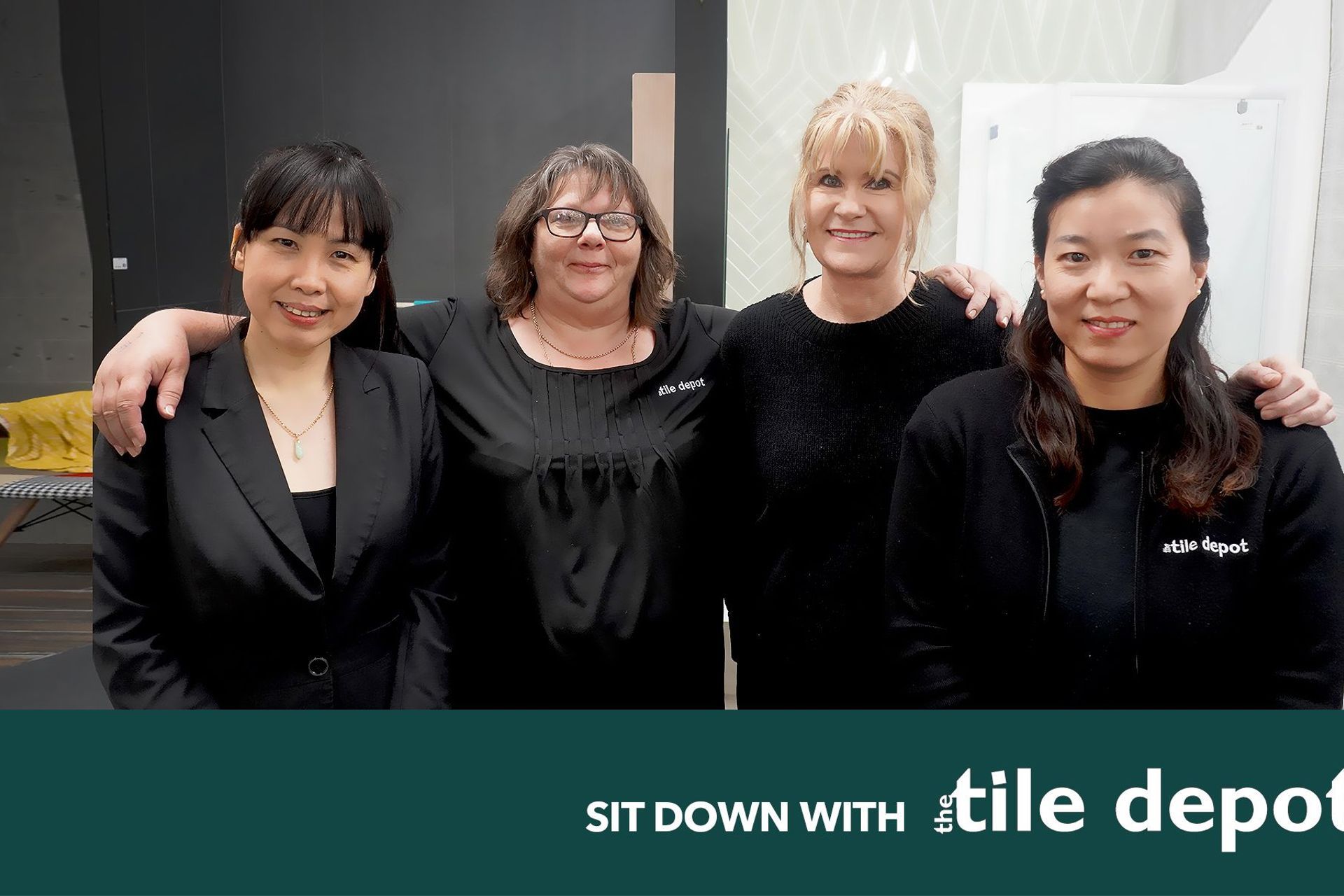
Materials of Kitchen Tiles Available today – Pros and cons for each
There are many materials of tiles available today and it is always good to know as much as possible about each material. Knowing about the materials will give you a better idea of what works for your kitchen. Tiles can be broadly categorised into manufactured and natural stone tiles.
Examples of Manufactured tile materials:
- Ceramic tiles
- Porcelain ceramic tiles
- Terracotta
- Glass
- Cement
Examples of Natural stone tiles
- Marble
- Granite
- Limestone
Non porcelain Ceramic Kitchen Tiles
Ceramic tiles are one of the most cost effective type of kitchen tile available and have an extensive range of styles to choose from. Ceramic tiles are a mix of minerals and clays which are baked and then the pattern or texture is printed on them.
Ceramic tiles are however quite hard and can be very cold in winter. They also can be chipped easily and have sound reflective properties which means that they should be avoided in open plan kitchens. We would also recommend clients to use larger tiles as this means that there will be lesser grout lines to clean as grout does get stained quite easily.
Tip: We would recommend our clients to use ceramic tiles as feature walls or splashbacks but not the floors unless you have underfloor heating. Installing underfloor heating can however be expensive.
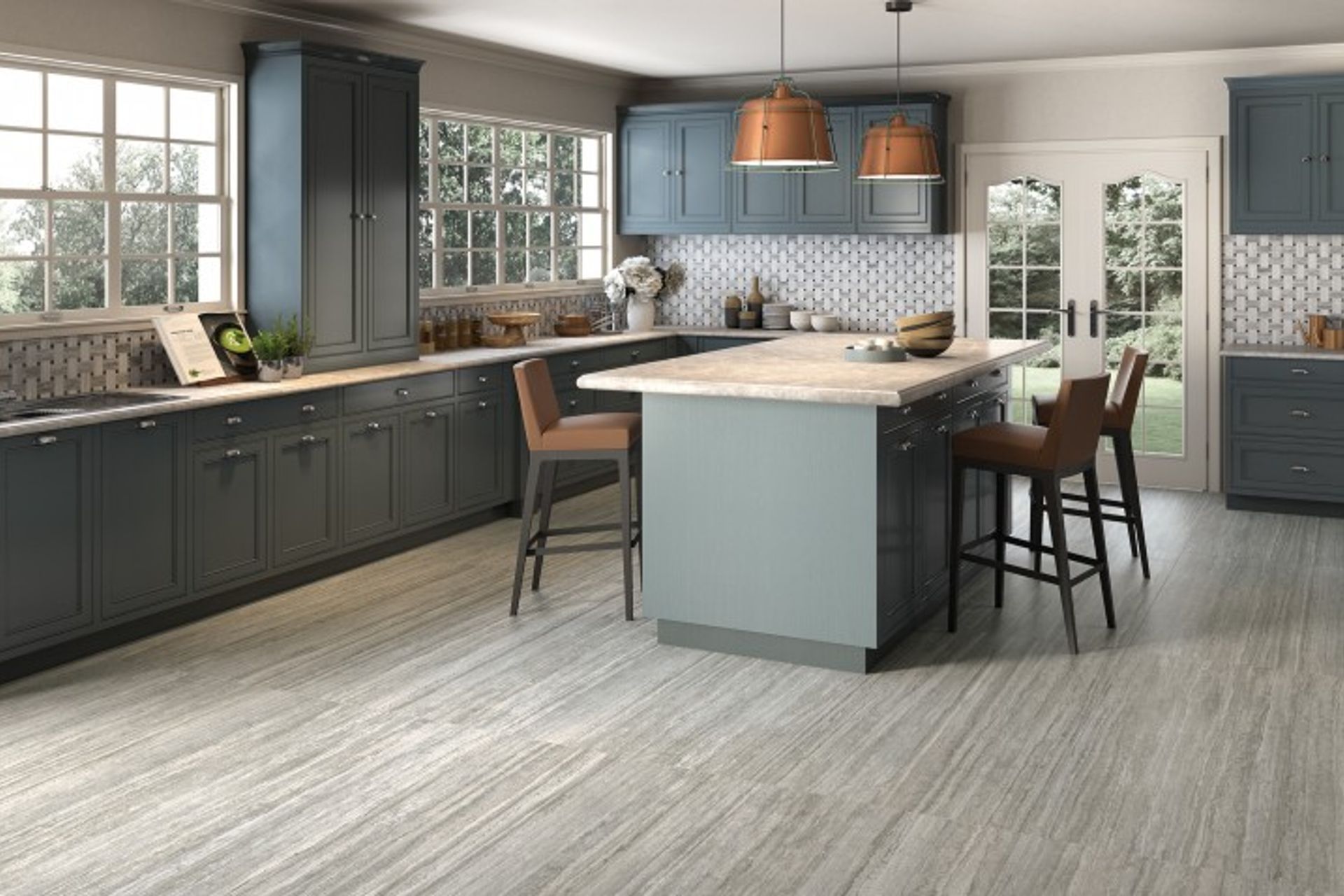
Porcelain Kitchen tiles
Porcelain Kitchen tiles are more expensive than ceramic tiles but are non-porous which means that they are harder to damage. They are made of high quality clay and minerals that are compressed under high temperatures.
They are harder than ceramic tiles which means that they are harder to cut and heavy. They do however can be made to look like stone engineered marble, Cement or wood which makes them a great design option. They also make for good outdoor tiles which means that you can achieve a great indoor and outdoor floor if your kitchen is extended to the outside of your home.
Glazed Vs Non Glazed Porcelain Kitchen Tiles All porcelain tiles are made by using natural clays and pigments which are then fired to harden them. This gives you an unglazed tile which looks more natural, has a textured look with a matte finish. Glazed tiles go through a second firing process, where a protective liquid glass coating is applied and a variety of colours or designs are printed upon this before firing them yet again. This give glazed tiles a slick look and they are often seen in more modern designs.
Unglazed porcelain tiles are textured and hence better for wet areas such as bathrooms, kitchen floors and laundry areas. They also feature more anti-slip properties when compared to glazed porcelain tiles. They are however harder to clean and are not ideal for kitchen splashbacks or as cabinet fronts. Glazed porcelain tiles are however more popular as they have a lot more variety in designs and colours. They are also easier to clean due to their non-porous surface and are often used as splashbacks, cabinet fronts and flooring for modern and contemporary designs.
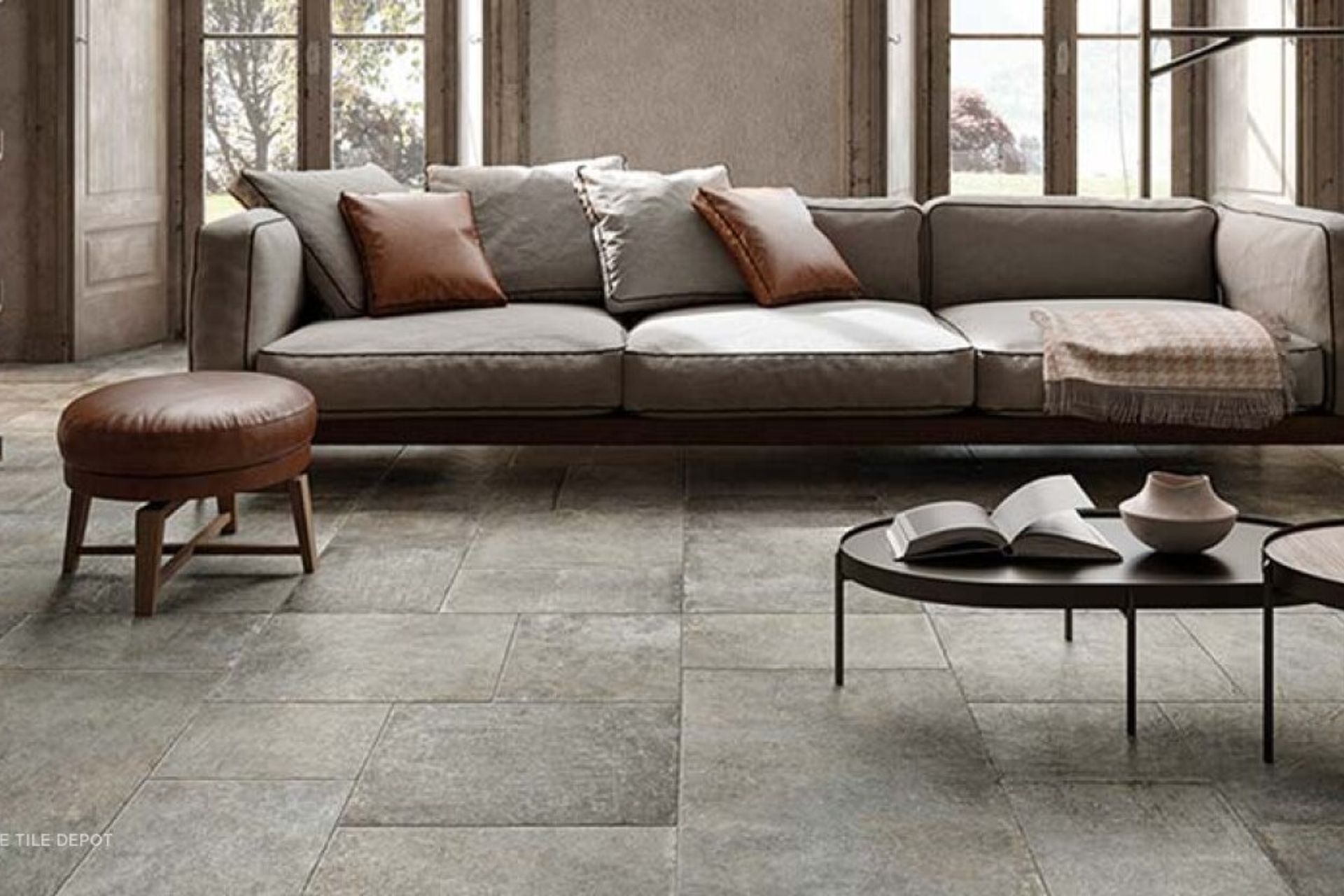
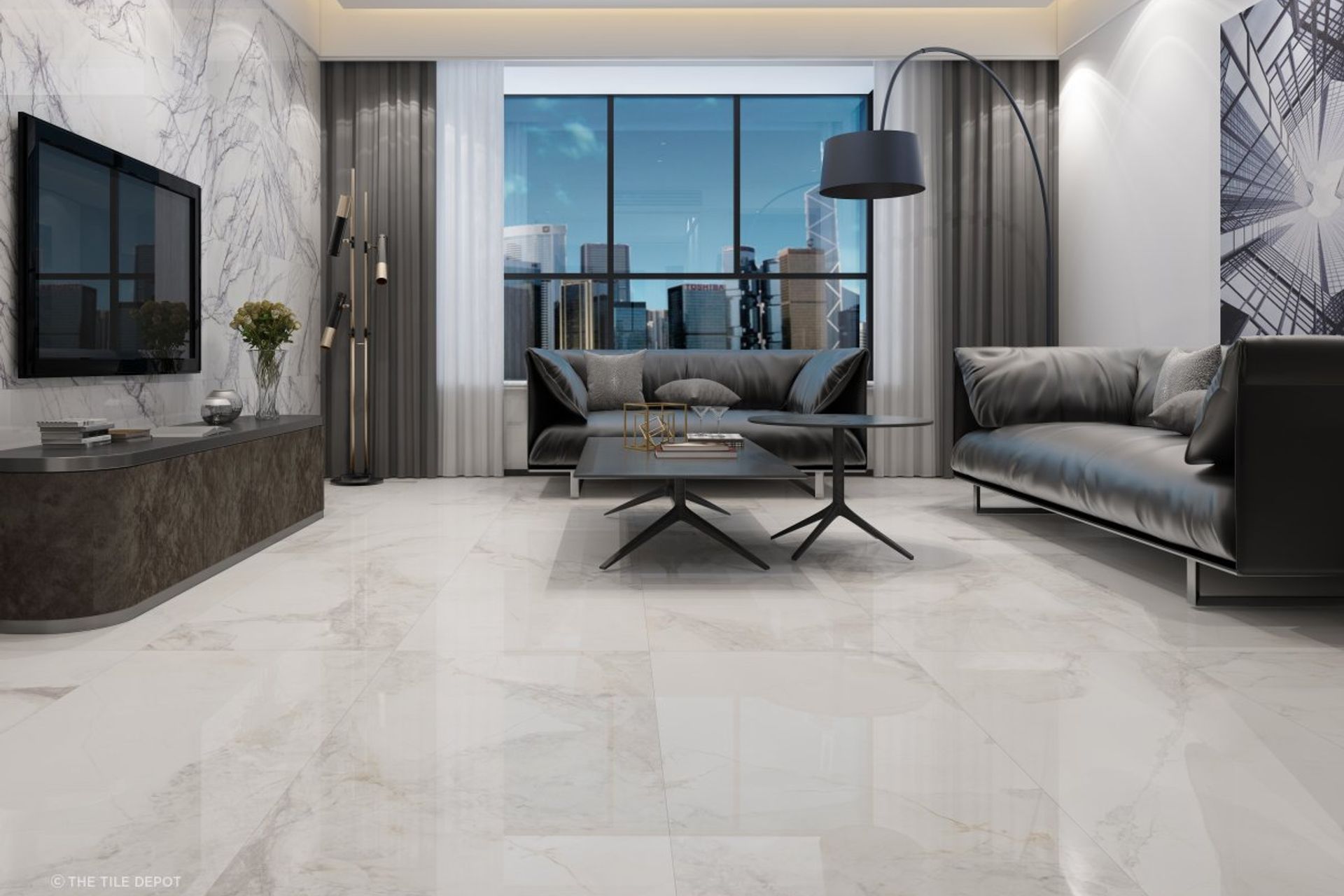
Glass tiles
Glass tiles have traditionally been popular as splashbacks, countertops, backsplash, and feature walls. Glass tiles have always been used as a decorative tile and are mostly used in mosaics for truly beautiful look. They are non-porous so they will not let any dirt or grime get into it. They are however easy to scratch, and the surface can look dusty easily and are extremely difficult to install which means that they are not the best option as kitchen flooring.
Mosaic tiles are small bits of glass that are put together to elevate a kitchen design. We recommend clients to use mosaics as accents on the wall with details like horizontal line etc to elevate the overall design of the kitchen.
Tip: Use it as a feature wall or detailing on walls but avoid using them as a flooring or a backsplash.
Stone Kitchen flooring Tiles
Stone tiles are made of natural stone and are not manufactured in the factory. Stone tiles are made of either limestone, granite, slate, or the more popular marble. Stone tiles are porous which means that they must be sealed every two years or so. They are usually polished so their natural design shines through, but they can be slippery when wet which can be a hazard for older people. While stone is durable, they can be a bit expensive to maintain as they must be resealed every 2-3 years. They will however last you a long time and give your kitchen a look of luxury which is hard to match with ceramic or porcelain tiles.
Marble flooring Tiles
Marble is the most common type of stone tiles used in New Zealand. They add a touch of understated elegance that will transform your kitchen into a luxurious space. As marble is a natural stone, you can expect some of your tiles to have different patterns which are natural to that marble tile. Marble tiles are however expensive so they might not suit every budget. You can however incorporate marble in smaller areas to save cost like the kitchen floor or splashback.
Granite Tiles
Granite tiles also have the naturally occurring flecks as marble, but they look a lot less luxurious as compared to marble. While marble exudes a sense of luxury, granite often does not add a sense of luxury. It is a cheaper alternative to marble tiles and choosing the right type of design is essential, so your flooring does not look dated. Granite tiles are not very popular as kitchen floor tiles in New Zealand but are often used outdoors.
Limestone Tiles
Limestone is almost never used as a kitchen flooring in New Zealand. It is often found as an outdoor tile, around the fireplace or as a feature wall.
Metal Tile and Resin Tiles
Using metal tiles is another great way to add some depth into your kitchen space as it elevates the over all kitchen design. They come in various shapes, sizes and finishes which make them a perfect addition as wall accents as well as feature walls.
Resin tiles add depth and dimension to a feature wall but they are prone to chipping so they should not be used in homes with very young children.5 things to think about before choosing your kitchen flooring tile material
Now that you know the types of materials available in tiles, you should consider the following factors before deciding on your kitchen tiles.
- Water resistance:
Kitchens need a good water resistance flooring, so you are not always worrying about your flooring getting damaged. When using tiles on your kitchen floors we recommend using tiles that are unglazed with an absorption rate of 0.5% and unglazed tiles wit a maximum rate of 3%. - Texture:
If you have elderly people in your household then you should go for more textured tiles as they are less slippery when wet. Textured tiles can however be quite hard to clean so they should be avoided in households that have young children as they are harder to maintain. If you have young children, then we recommend using mats in front of your sinks or wet areas. - Durability and measure of PEI:
Durability refers to how well your tiles can withstand wear and tear. So how do you check the durability of a particular tile? The best way to check the durability of a tile is to check its PEI rating. The PEI rating of a tile is the measure of its resistance to abrasion. The higher the PEI rating the more it can withstand wear and tear before showing signs of deterioration. In most households, kitchens are considered a high traffic area and hence should have flooring that has a high PEI rating. We recommend our clients to use kitchen tiles that are rated at PEI 3 or PEI 4 as they are the best for high traffic areas. You can however use PEI 1 or PEI 0 rated tiles for feature walls as they do not have any foot traffic. - Underlay:
Tiles should always be installed on a surface that is smooth, even and level. If your floor is not even then you might have to install a subfloor that is even, smooth and hard before you lay your tiles. It is always good to get your subfloor checked before you decide on your kitchen flooring. - Natural Lighting:
People often do not think about the amount of natural lighting in their kitchen and the importance of it before purchasing their tiles. A tile in a well lit showroom or online on a website can look very different when compared to the tile within your kitchen.Glossy tiles for example are work well in smaller spaces with less natural lighting as reflect light and make the room look more lit up. This is also true with lighter coloured tiles as they reflect light and make the space appear larger.In Discussion with Ruth from Tile Depot
As our preferred tiles supplier, we work very closely with Tile depot for flooring and tiling needs of our clients. Our project managers often seek advice from Ruth when it comes to choosing the right type of tiles for our client home renovations.
With this article our aim is to educate our clients on the type of tiles suited for their floors, backsplash, and feature walls so we decided that it was time to have a chat with Ruth. Ruth has over 16 years of experience with Tile depot, and she has extensive knowledge on the myriad of options available for tiles.
It is often very overwhelming when you walk into a tile showroom because there are so many options, and it is hard to make a choice.
When choosing kitchen tiles for our clients we believe that there are a few things that need to be considered before selecting a tile.
6 Questions to ask yourself before you choose your Kitchen tiles
1) What is your budget?
When renovating your kitchen, it is important to have an idea on what you want to be spending for tiling your kitchen. Tiles can really transform the look of your kitchen and some clients often feel that they would prefer making a statement through the clever use of tiles. For such clients we often recommend using porcelain tiles as they can be manipulated to look like wood, cement, or natural stone. They are more expensive than ceramic tiles but are more durable and of a higher quality so will last you a longer time.

If your budget allows, then we would recommend using natural stone tiles which add a sense of luxury and elegance to your kitchen. If you do however have a rental property, then you are looking for a return of your investment. For rental property renovations we recommend using tiles that are durable but also cost effective which could make ceramic tiles the best option for you.
You should always have an honest chat with your project manager about your budget so they are able to suggest the right options for your kitchen tiles. The good news is that tiles have evolved dramatically over the years and there are a lot of texture and design options no matter what your budget is.
2) How much cooking happens in your kitchen? And how much time do you spend in your kitchen?
Pro tip: Choose tiles that are easy to clean + Soft on your feet
Kitchen tiling needs for households that cook a lot is very different from the ones that do not cook as much. If you do cook a lot in your kitchen then will want to choose a backsplash which is easy to clean with a simple wipe. You might also want your flooring to be soft on your feet, so you do not tire easily when cooking for extended periods of time.
Kitchen flooring to consider
Most tiles are hard on the feet and can cause foot fatigue so no matter what tiles you chose your floors will be hard on your feet. You can remedy this situation by adding rugs on your kitchen floor or wearing comfortable shoes.
Ruth explains that there are alternatives to using tiles on kitchen floors if you do not want to add rugs and if you want a flooring that is softer on your feet. Laminate and wooden flooring care softer on your feet and will not make you as fatigues compared to tiles.
She also recommends a new hybrid flooring called SPC by Neptune which is becoming increasingly popular with Aucklanders for their kitchen floors. SPC stands for stone (limestone) polymer composite and has many benefits over tiles for your kitchen flooring. It is a mix of limestone and Vinyl and is manufactured in a way that it carries the benefits of both these materials.
Benefits of Neptune SPC
- It is 100% waterproof which means that they are perfect for kitchen floors
- It is softer on your feet as it embodies the qualities of limestone
- It does not echo the sound of footsteps and reduces the noise of any foot traffic. This is great for kitchens which are on the second storey of the house as you will not be able to hear any footsteps even if you are directly below the room.
- It is easy to clean and maintain
- It is much warmer than tiles so you will not require underfloor heating, warm rugs, or shoes while cooking.
If you do however prefer tiles for your kitchen floor, then opt for porcelain or natural stone tiles instead of ceramic. Also consider installing underfloor heating for the colder winter months.
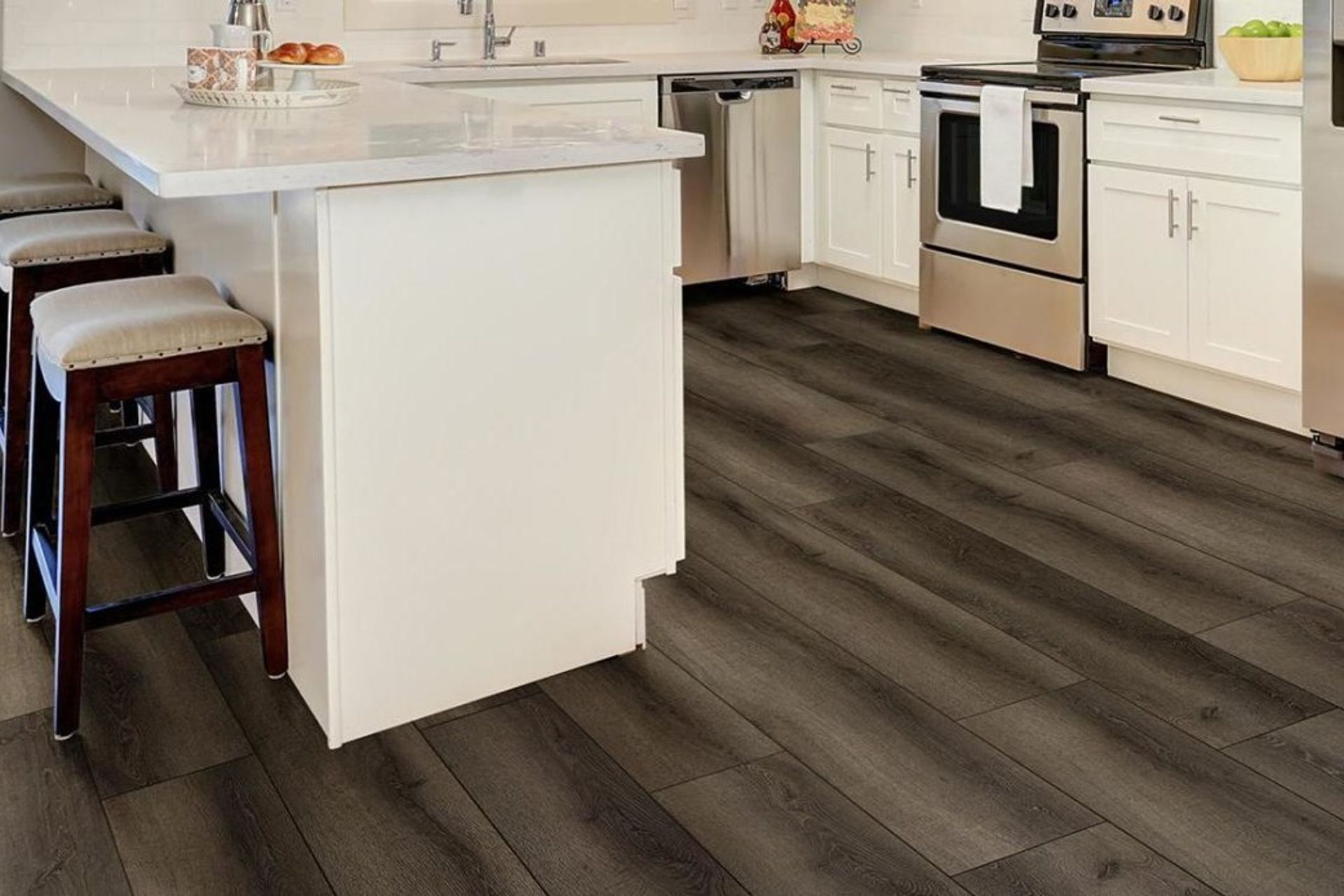
Kitchen Splashback tiles to consider
If you do cook a lot, then install a kitchen backsplash tile with fewer grout lines or grout lines that are sealed. If your grout lines are not sealed, then you will have to keep cleaning your grouting as they are easily stained.
It is also a good idea not to choose textured, 3D or handmade tiles as you will not be able to wipe off the stains easily. If you do however like handmade tiles, then we suggest using tiles that look man made and textured but are in fact have a smooth surface that is easy to clean.
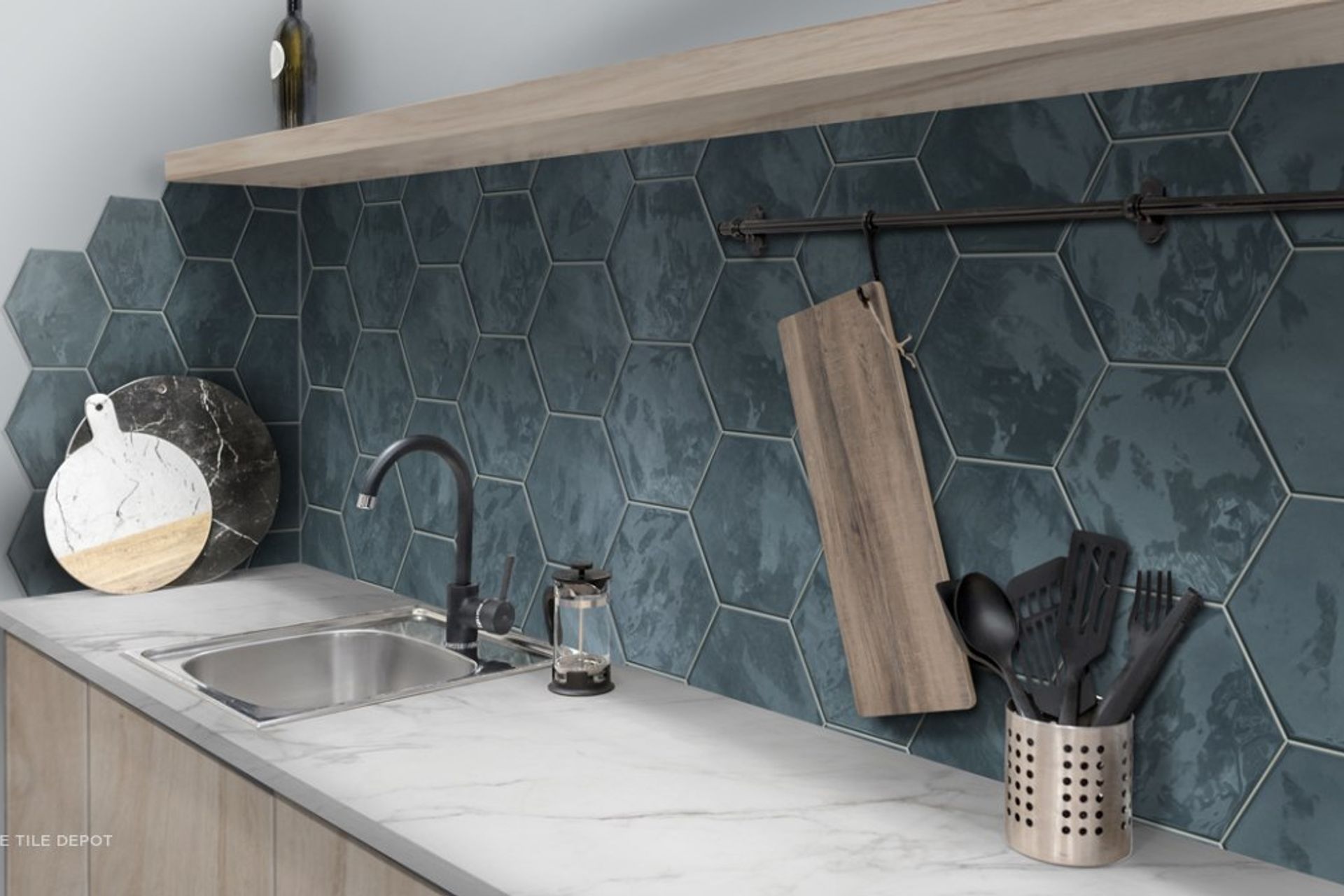
An example of this is the handmade looking tiles from Tribeca. These tiles look like they are handmade and have textured patterns but are in fact smooth on the surface and very easy to clean. They will also add an interesting design element to your kitchen.
Tribeca tiles are however on the more expensive side so if you are looking for a more budget friendly kitchen splashback tile then opt for either a glass splashback or white subway tiles as they are very cost effective. You can also install one large piece of ceramic or stone tile as a splashback if you do not want grout lines at all. Do not use porcelain as a splashback because they are very heavy and installation might be a problem.
3) Is it a high traffic area for your family?
You might not cook a lot but your kitchen could still be considered a high traffic area if several members of your family are always coming in and out of the kitchen. This could be to simply have a tea or use the island as a breakfast nook. If you have an open plan kitchen then there are higher chances that the kitchen will be a high traffic area.
If you kitchen is a high traffic area then your kitchen flooring should be easy to clean and also not echo your footsteps. For high traffic kitchens Neptune SPC flooring would be best for your kitchen as they are waterproof and do not echo sounds when people are going in and out of the kitchen.
Porcelain kitchen tiles and stone kitchen tiles will also be better compared to ceramic tiles as they are more waterproof than ceramic. You could also add rugs to the kitchen to control the noise made by footsteps. The sound of the footsteps should not be much of an issue if your kitchen is on the ground floor of your house. The noise mostly becomes an issue when the kitchen is on the 1st floor and if there are bedrooms or living areas underneath it.
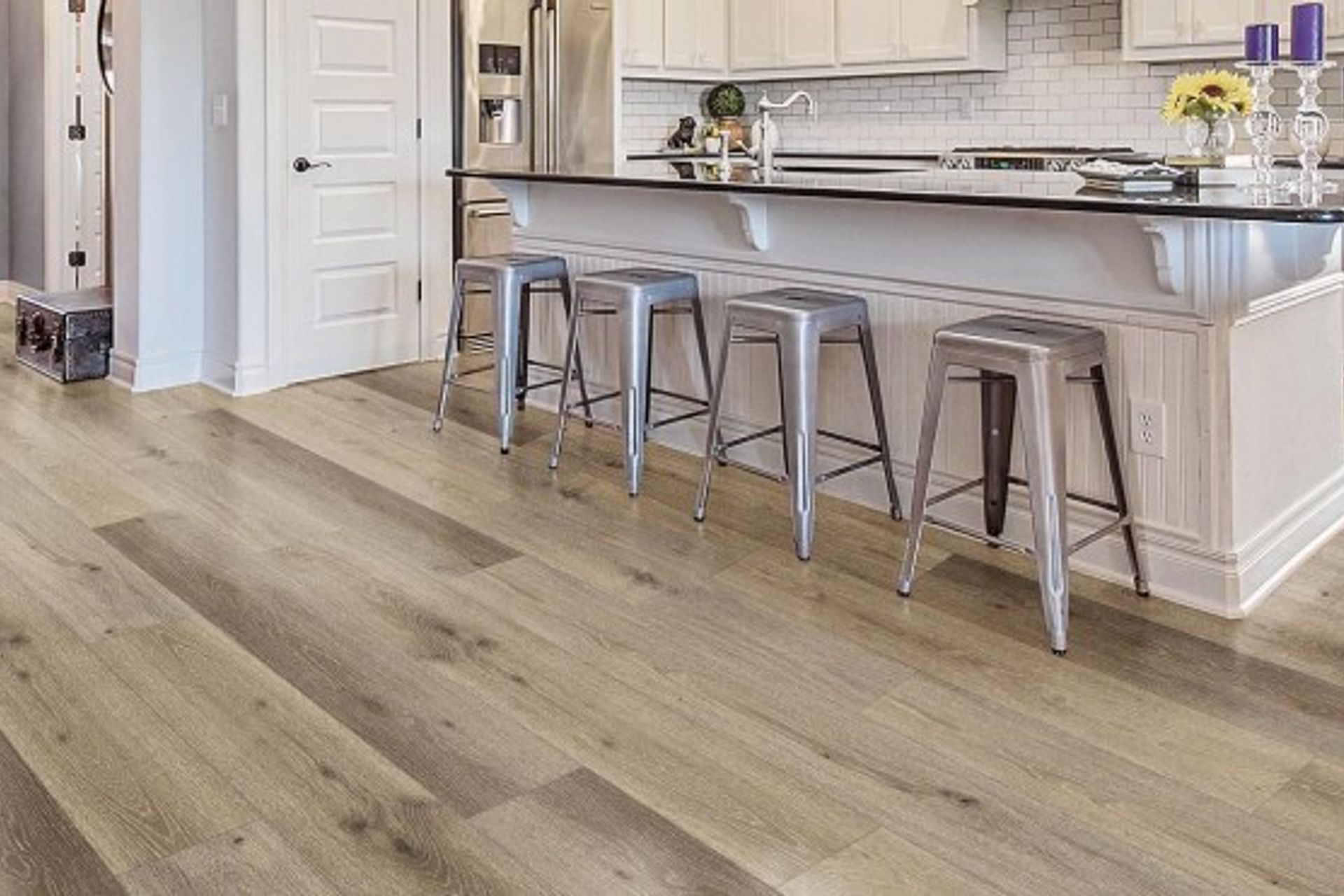
For more budget friendly options, you could opt for luxury laminate for your kitchen flooring as they are softer on the feet, easy to clean and do not echo the sounds of footsteps. If you are installing laminate floors, then do remember to clean the floors immediately in case of any water spillage as they are not waterproof.
4) Is it an open planned kitchen or is your kitchen a separate room?
Open planned kitchens pose a unique challenge when choosing the materials for the kitchen. As your kitchen will be visible from the living and dining area, you want to make sure that your kitchen is renovated in a similar style as the rest of the living space.
Our kitchen designer Cici says that the two most important things about an open planned kitchen is to have a continuity in design with the rest of the living room area. When choosing splashbacks, flooring, feature walls, countertops, and tapware, always make sure that they complement the rest of your living space.
Before starting your renovating, ask your kitchen designer to come over to your home for a visit so they can see the overall design of your living space. Try and have a similar colour scheme for your walls or go for a contrasting style which still complements the style of the rest of the space.

Choose kitchen tiles that are like the ones in your living and dining area for a seamless feel. If you are changing the flooring of the entire living area, then opt for natural stone or porcelain tiles. These tiles elevate the design of a room a lot more than ceramic tiles as ceramic tiles can look dated.
When asked Ruth what the current trend was for open planned kitchens, she said “the current trend is to get a stone matte finish tiles for your living and kitchen area”. These porcelain tiles are glazed and hence easy to clean which makes them a popular choice for open planned kitchens. They are more cost effective than natural stone tiles like marble so are more suited for most budgets.
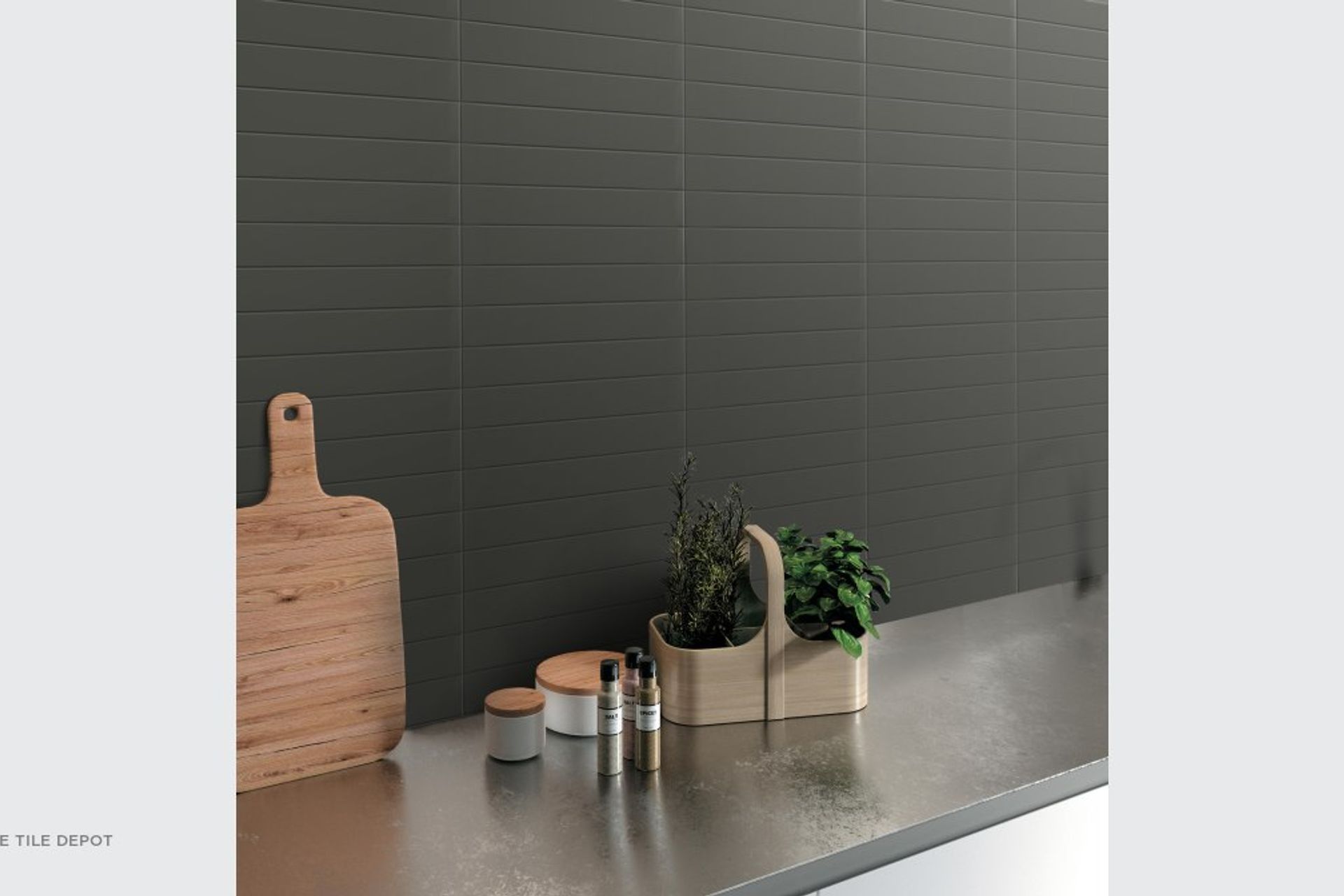
5) Do you have children and hence need tiles that can be cleaned easily and are warmer?
If you have young children, then you might want a flooring that is warmer and not easily scratched. Use glazed porcelain tiles or natural stone tiles for the floors and install underfloor heating if your house does not already have it. Luxury laminate is also an option but it can sometime be scratched easily so might not be the best option if your children are too young.
6) Does your kitchen floors need non-slip tiles?
If you have elderly people living in your house then you should install tiles that have a good anti-slip rating. Tile depot carries an extensive Lifemark range of kitchen tiles that are suited for households that need anti slip tiles.
“In addition to anti-slip tiles, we also have this new range of Microgrip kicthen tiles that are great for bathrooms as well as kitchens. They basically become anti-slip when water falls on them. They also have anti-bacterial properties so these are truly a revolutionary product” says Ruth about their newest range of Microgrip kitchen tiles.

Ruth Shares Current trends for Kitchen Flooring, Kitchen Splashback and Kitchen Feature walls for Auckland homes
Ruth deals with clients who are renovating, building their homes from scratch, new builds, architects, and renovation companies. We wanted to know more about what Aucklanders were using for their kitchen flooring, Kitchen splashback, and tiles. She gave us some great insights to Aucklanders’ buying habits and the trends that she has seen for tiles as well as the trends that have begun to decline.
5 Kitchen Splashback/ Backsplash tile trends for Auckland kitchens
1.White subway tiles are on their way out
“The white subway look has really been overdone and does not add much to a kitchen” says Ruth about white subway tiles. White subway tiles became very popular as kitchen splashbacks as well as wall tiles for bathrooms in the last few years because they added a contemporary flair to the kitchen. More people are now looking at ways of adding colour and interest in the kitchen through splashbacks.
2. Earthy and warm kitchen backsplashes are becoming a popular choice
Ruth says that more people are now are choosing warm and earthy colours for their backsplash. Earthy colours often bring in a sense of warmth into the kitchen and make it look more homely. They are also a way of bringing some nature into the décor of your kitchen which has become a popular trend in the last few years, especially for urban homes like Auckland.

3. Handmade looking kitchen backsplash tiles
There has been a growing trend of adding artistic elements to the overall kitchen design. People often add these touches through artistic backsplashes, feature walls or accessories while choosing simpler contemporary materials for cabinets and floors.

Tiles which are handmade have patterns, carvings and often textured which is not suitable for backsplash as all these nooks and crannies can be hand to clean. Thanks to technology however, tiles can be made to look handmade without being handmade. The new Tribeca collection from Tile depot features handmade looking tiles which are smooth when you touch the surface which makes the, a great choice for backsplash.
4. Kitchen backsplash tiles with Patterns
Patterns are another way to incorporate an artistic touch to your kitchen design. Ruth says that the artisan tiles can also be used as accents to the walls instead of just a splashback or an entire feature wall. Adding accents or a horizontal like of artisan tiles on your kitchen wall will instantly elevate its overall style without costing you a lot.5. How you install the tiles Ruth says that there are two ways that you can dramatically change look of your kitchen. The first would be the tile and the second is the way you install the tiles. “you do not have to always install the tiles horizontally, the new trend has been to be creative in the way the tiles are installed” says Ruth.
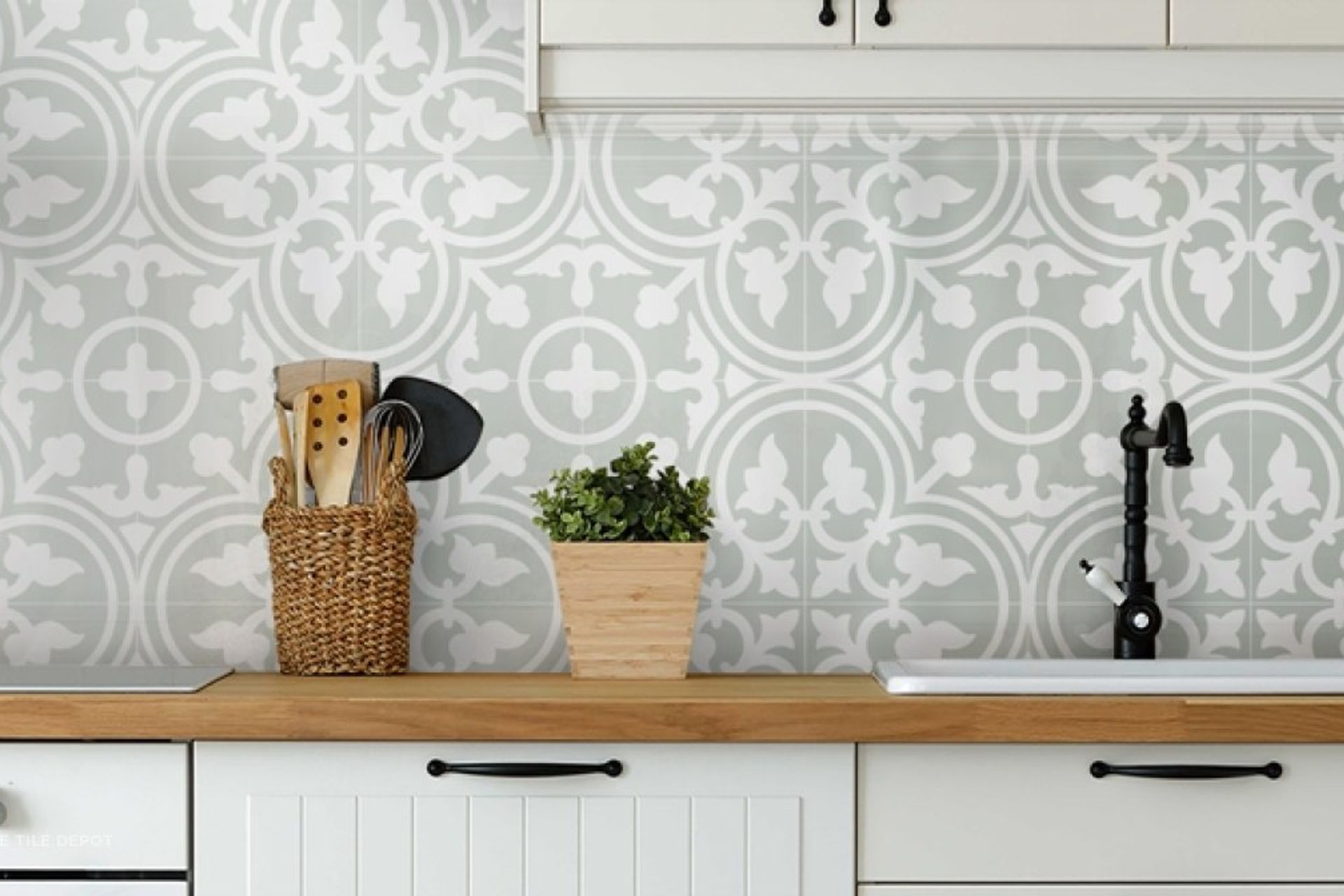
5. How you install the tiles for your backsplash
Ruth says that there are two ways that you can dramatically change look of your kitchen. The first would be the tile and the second is the way you install the tiles. “you do not have to always install the tiles horizontally, the new trend has been to be creative in the way the tiles are installed” says Ruth.
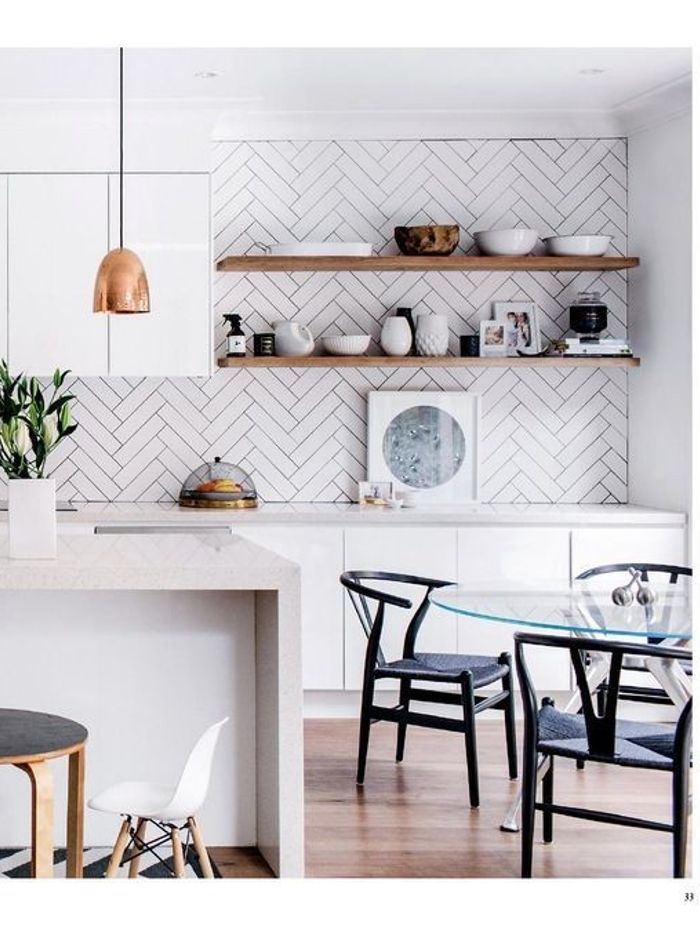
5 kitchen flooring trends in Auckland by Ruth
1. High-end look with stone matte finishes
As most kitchens in Auckland have evolved into an open planned layout, there has been a greater emphasis on aesthetics within a kitchen design. Ruth explains that she has seen a rising trend in Aucklanders opting for a high end look by selecting tiles that look like stone and have a matte finish. Glazed porcelain tiles are great for most budgets to create this look as they are a cheaper option compared to natural stone tiles. To create continuity, install the same tiles in your dining and living areas if you have an open plan kitchen.
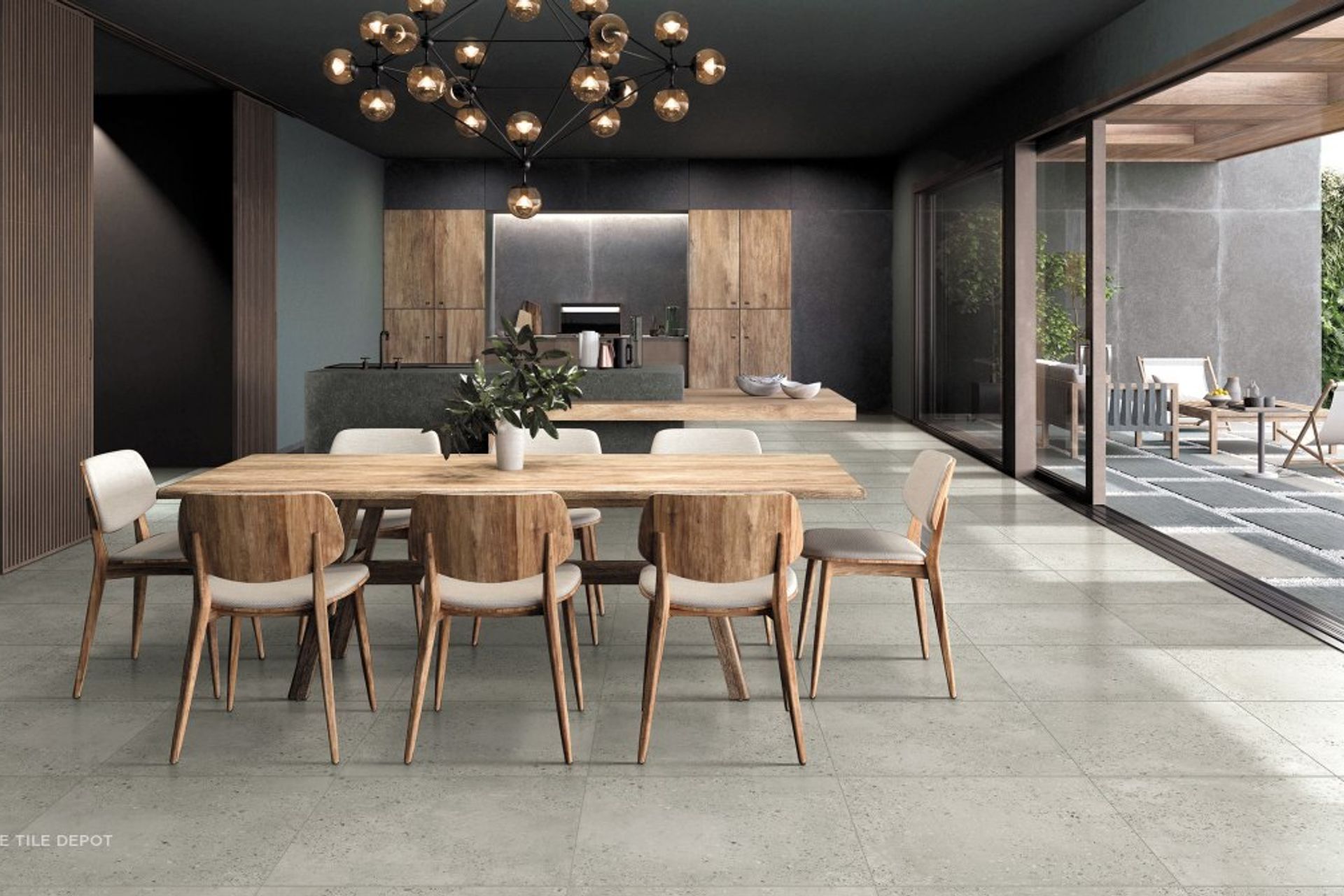
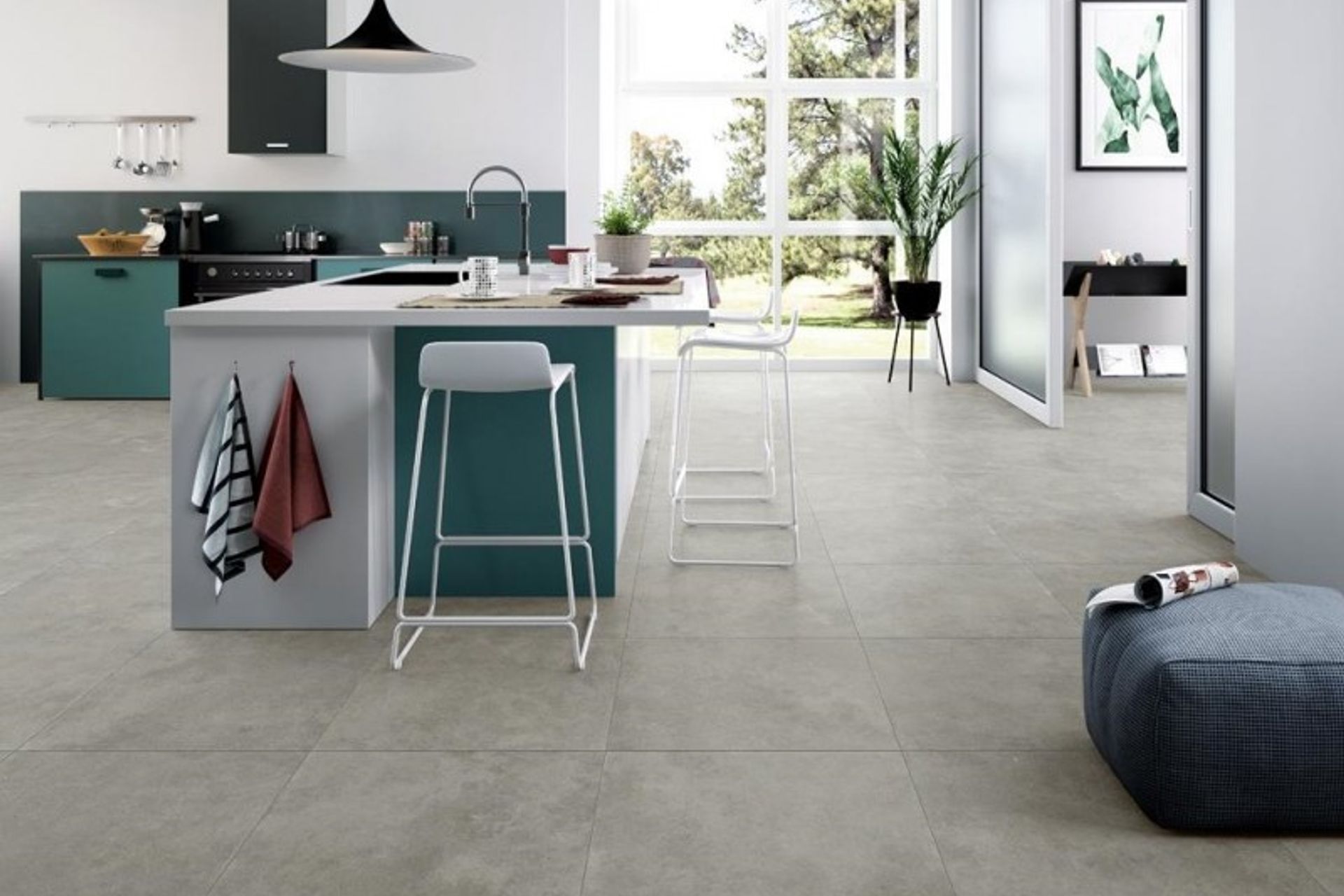
2. Shiny tiles are declining in popularity
Shiny tiles have been very popular in the last couple of decades and remain popular to a certain extent. However, more people are gravitating towards the matte finish because it exudes a certain kind of understated elegance. We still recommend people with small kitchens or bathrooms to install shiny tiles as they reflect natural light as well as any other light and make your spaces appear larger.
3. Large tiles 1200 by 900
Larger tiles have become increasingly popular as they have lesser grout lines and provide a cleaner look. Having lesser grout lines also means that you if you have a small room then it will make it look larger as there are ‘lesser breaks’ on the kitchen floor. The most popular size for large tiles is 600 by 900 and 1200 by 900.
4. No grout lines
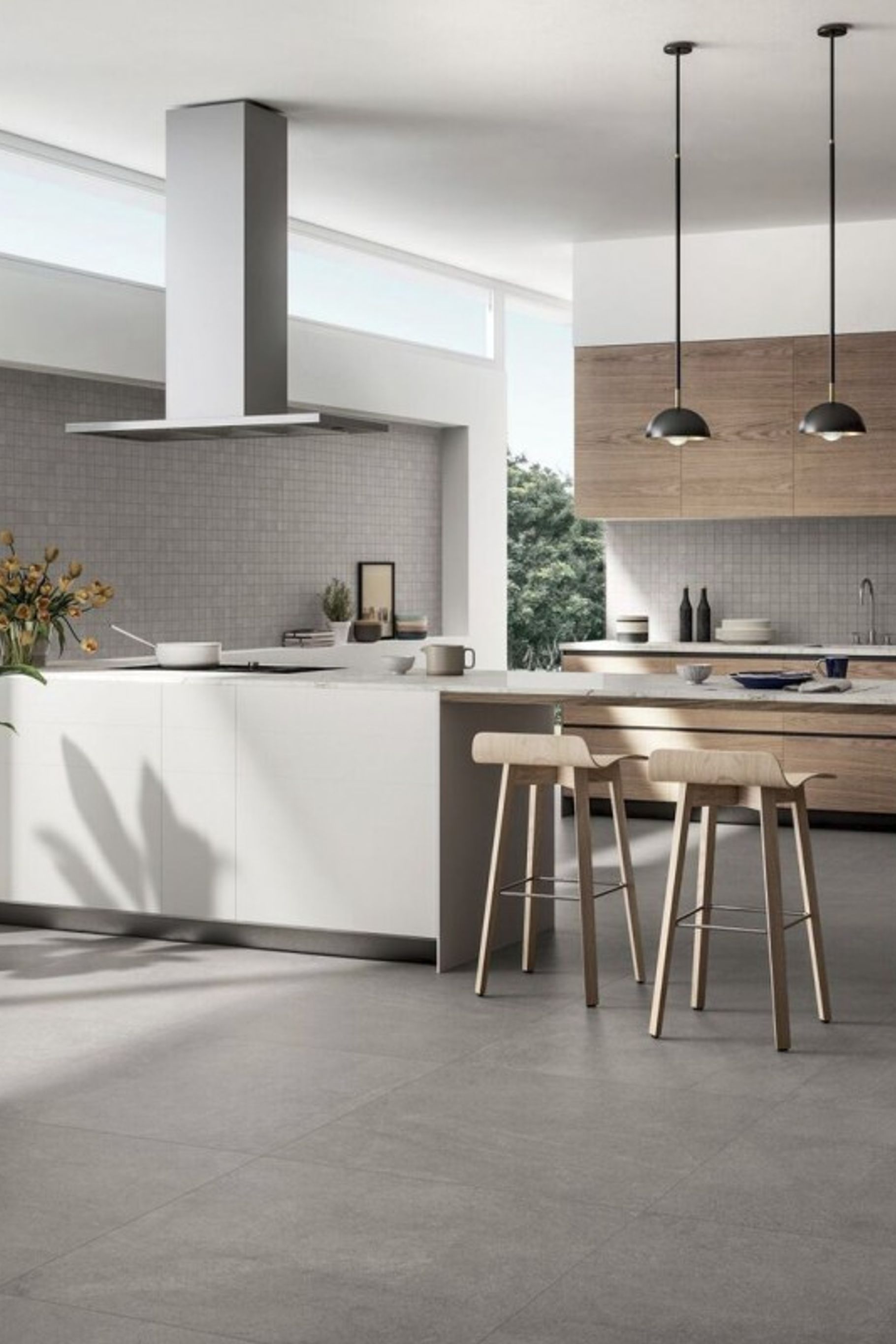
As mentioned above there is an emphasis on having lesser grout lines for kitchen flooring. You can also match the colour of your tiles with the grouting to give you an appearance of having no grout lines.
5. Woodgrain tiles have seen a decline in popularity
Woodgrain tiles have been quite popular in the last decade but have seen a decline in popularity. Woodgrain tiles look and feel like natural wood which is great for people who want wooden flooring but not the hassle of maintaining them. However, as more people are opting for contemporary styles for their homes, they prefer a natural stone look as compared to wood grain tiles.
6 ideas for feature walls for your open plan kitchen
1. Woodgrain tiles as feature walls have seen an increase in popularity
While woodgrain tiles might be declining in popularity as floors, they are seeing an increase in popularity as feature walls. There has been a growing trend of incorporating elements of nature in urban Auckland homes which makes woodgrain tiles a great option as a feature wall.
2. Designer tiles with designs of nature
A lot of people want a feature wall because they want to create a ‘wow’ factor. They often keep the rest of their colour scheme neutral and create a feature wall with floral prints. Ruth tells us a bit more about their range of glam tiles which come in 1200 by 900 size and has three different patterns which are put together to create a scene of nature.
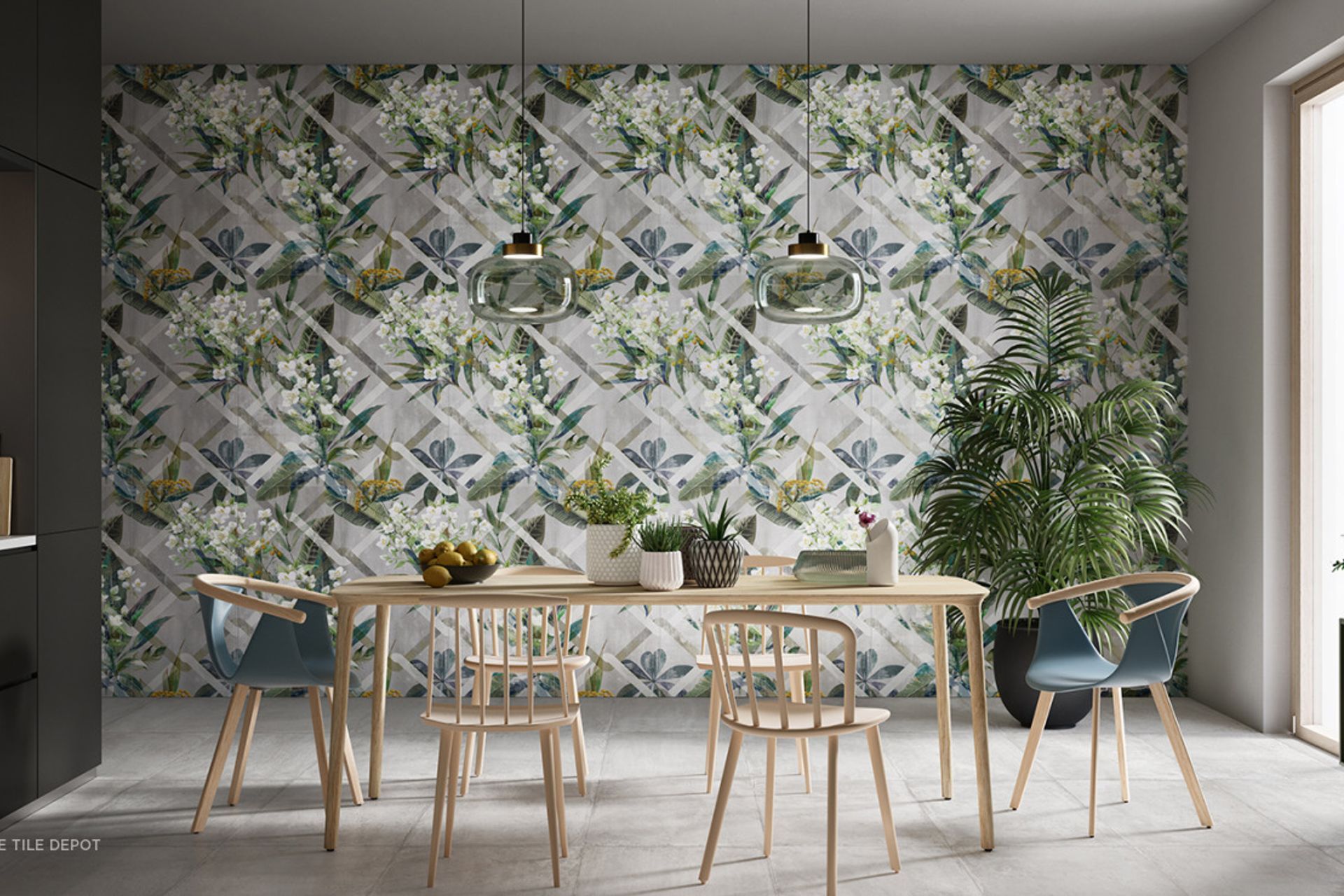

There are many options to choose from for textured tiles. You can use natural rugged stone or brick tiles around your fireplace or for a more rustic styled living area. You could also add a feature wall with geometric and 3d patterns for a more modern or contemporary look. Mosaics have always been a popular choice as they make your space look artistic and Moorish. Regardless of your budget, you will find plenty of options for feature walls.
4. Accents in feature walls
If you do not want an entire wall of tiles for your feature wall, then you can install wall accent tiles. You could install small beads or mosaics in a horizontal or vertical line on the wall of your kitchen. You could create patterns or designs on the wall without tiling your entire wall. If artistically done, this could add a certain elegance to your wall but we do recommend consulting a designer before go ahead full steam.

5. Creating interest through installation
As mentioned earlier, the way you install your tiles can also make a huge difference on the final look of your feature wall.
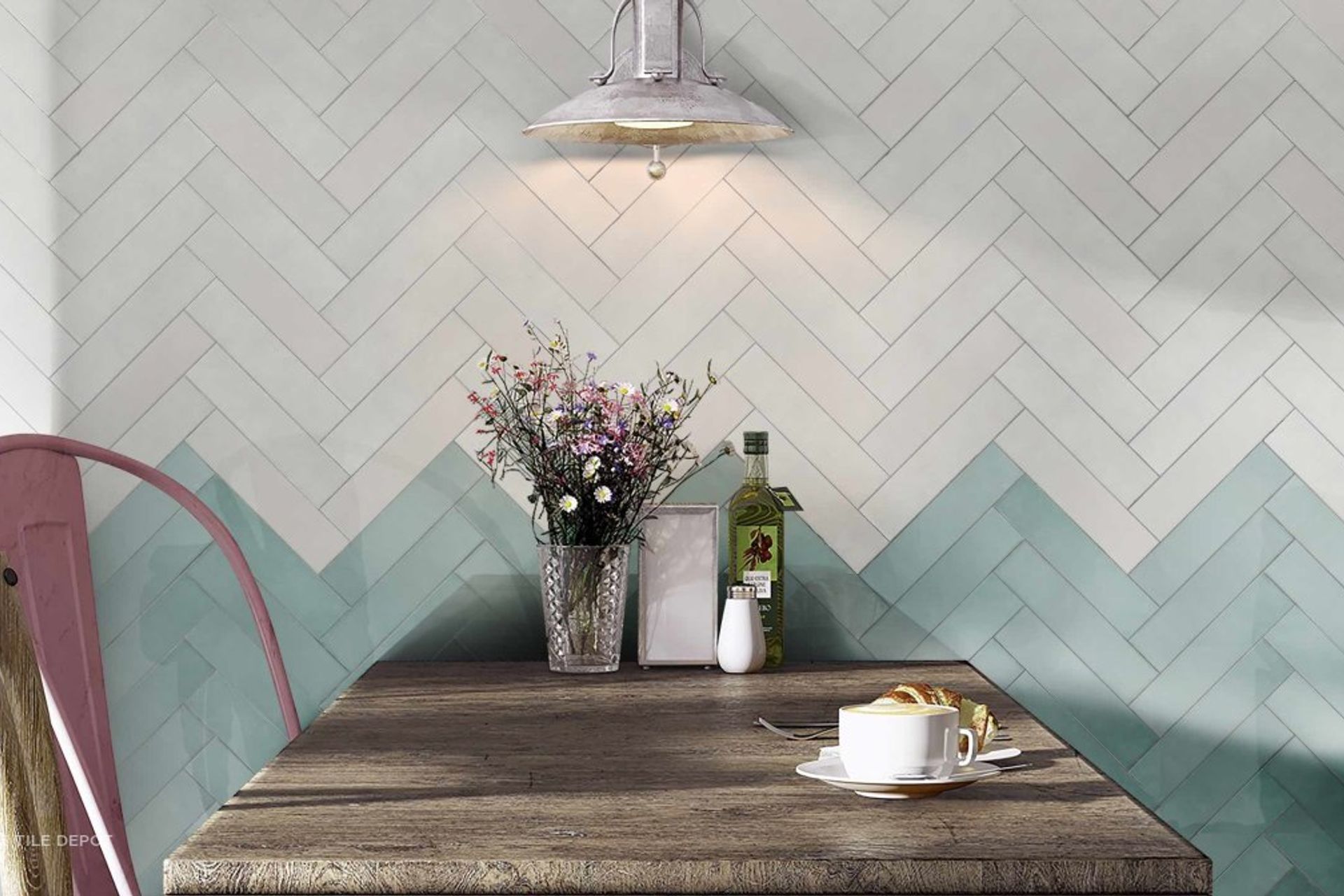

6. Bright and Bold colours
If you have a neutral colour scheme then opt for bright or warm colours to create contrast. You could also add matte dark grey tiles as a feature wall to create a dark and stormy mood for your living space.

“The biggest mistake people make when they choose tiles is that sometimes they choose tiles that clash with eachother or there are too many patterns that do not work well together. It is important that you create a story with the tiles that you choose for your kitchen flooring, Splashbacks and Feature walls” Says Ruth when asked what is the most important aspect of choosing tiles.
